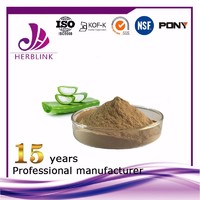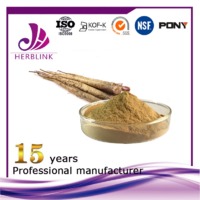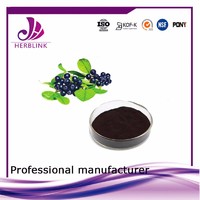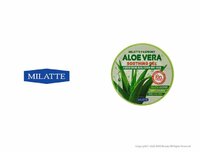Aloe Vera Extract for Gel
Product Quick Detail
- FOB Price
- USD $99.00 / Piece
- Place Of Origin
- China
- Minimum Order
- 1
- Packaging
- N/A
- Delivery
- 15 Days
Specifications
Latin Name: Aloe vera L. var. chinensis
Synonyms: Aloe africana, Aloe arborescens, Aloe barbadensis, Aloe Capensis, Aloe ferox, Aloe frutescens, Aloe Gel, Aloe indica, Aloe Latex, Aloe Leaf Gel, Aloe natalenis, Aloe Perfoliata, Aloe perryi, Aloe spicata, Aloe supralaevis, Aloe ucriae, Aloe Vera Barb
Part of Used: Leaf and stem
Specifications: Aloin20%-80%, triterpenoid A+b 20%-70%, Spray-drying(water-soluble), 100:1 Spray-drying and Freeze-drying
Appearance: Yellow fine powder
Application: Medicine, food additive, dietary supplement
What is Aloe Vera Extract?
According to wikipedia,Aloe vera is a succulent plant species that is found only in cultivation, having no naturally occurring populations, although closely related aloes do occur in northern Africa. The species is frequently cited as being used in herbal medicine since the beginning of the first century AD. Extracts from A. vera are widely used in the cosmetics and alternative medicine industries, being marketed as variously having rejuvenating, healing, or soothing properties. There is, however, little scientific evidence of the effectiveness or safety of Aloe vera extracts for either cosmetic or medicinal purposes, and what positive evidence is available is frequently contradicted by other studies
Leaves from all aloes have long been credited with healing properties, but the especially succulent Aloe vera is valued most.
Aloe Vera contains many vitamins including A, C, E, folic acid, choline, B1, B2, B3 (niacin), B6. Aloe Vera is also one of the few plants that contains vitamin B12.
Some of the 20 minerals found in Aloe Vera include: calcium, magnesium, zinc, chromium, selenium, sodium, iron, potassium, copper, manganese.
Chemical constituents of Aloe Vera Extract
Aloe Vera Extract contains Aloeemodin, Aloin,Barbaloin, Isobarbaloin, Homonataloin, Chrysophanol, Chrysophanol glucoside, Anthranol such as Anthracene classes and their glycosides. Also contains Quercetin, Camherenol, Rutin such as Flavonoids and glucose. Also contains Mannose, Ala-binose, Rhamnose, Susrose, Xylose, Fructose, Glucuronic acid such as Sucrose Mortierellate.
Also contains arginine, asparagine, eight kinds of essential amino acids such as glutamic acid, and Cholesterol and Campesterol, sitosterol.
Also contains Capric acid, Lauric acid, Myristic acid, Oleic acid, Linoleic acid, Palmitoleic acid, Succinic acid, Lactic acid, Linoleic acid, Palmitoleic acid, Succinic acid, Lactic acid such as Fatty acid substances and Twenty kinds of inorganic elements and vitamins.
Benefits of taking Aloe Vera Extract supplements:
Aloe Vera has been used therapeutically for many centuries in China, Japan, India, Greece, Egypt, Mexico and Japan.
- Country:
- Business Type:
- Market:
- Founded Year:
- Address:
- Contact:yu zhang
Other products from Herb Extract
Relate products of Aloe Vera Extract for Gel
100% Natural, made from pure aloe vera leaves. This hydrating oil deeply moisturizes skin and hair, soothes irritations, and promotes skin regeneration and repair. Rich in essential fatty acids, vitamins A, C, and E, it helps improve skin elasticity, reduce signs of aging, and ...
Aloe vera gel from the nature comforts and soothes irritated skin with its extra refreshing and moisturizing texture. Mild enough even for sensitive skin. 6 free of Paraben, Methyl, Ethyl, Propyl, Butyl, Isopropyl, ...
The Advantage of Aloe Vera And Acai Hand Cream Our aloe hand lotion is made of shea butter, ceramide and aloe vera. It has nourishing and moisturizing effects and can improve the appearance of dry, aged or cracked skin. Combined with ceramide, aloe vera gel hand cream can ...












